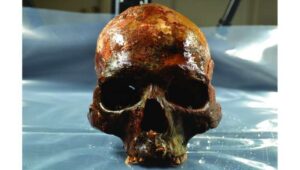
Discovered in Motala, Sweden, during excavations in 2009-2011, the Tomb of the Sunken Skulls is an enigmatic and haunting archaeological site that dates back to the Mesolithic era, around 8,000 years ago. This ancient site, situated at the edge of what was once a lake, offers a rare and startling glimpse into ritualistic practices of hunter-gatherer societies in prehistoric Scandinavia. The discovery challenges our understanding of Neolithic cultures, particularly in terms of their burial customs and spiritual beliefs.
The Tomb of the Sunken Skulls consists of an underwater repository containing the remains of at least 11 individuals, both adults and children, along with an array of animal bones. What makes this site particularly fascinating and somewhat macabre is the condition and presentation of these human remains. Several of the skulls found at the site were mounted on stakes, and two of these skulls contained fragments of the stakes within them, suggesting they were placed there intentionally. This practice of mounting skulls is rare and has sparked much speculation about the purpose and meaning behind this ritual.
The analysis of the site and the remains has provided insights into the life and death of these early Europeans. Isotopic analyses of the bones suggest a diet rich in fish, indicating a lifestyle deeply connected to the lake. The presence of tool marks on some of the skulls and bones implies that they were deliberately shaped, perhaps as part of a ritual or ceremonial practice.
The reasons behind these rituals remain shrouded in mystery. One theory is that the mounted skulls could be part of a forebears’ cult, where the skulls of ancestors or respected community members were venerated. Another possibility is that they were trophies from conflicts or skirmishes, a display of power and warning to enemies. Alternatively, this could have been a ritual associated with death and the afterlife, a way of remembering and honoring the dead.
The discovery of animal remains and artifacts, including tools and weapons, alongside the human skulls adds layers to the site’s interpretation. These items could have been offerings or possessions of the deceased, suggesting a belief in an afterlife where such items were needed.
The Tomb of the Sunken Skulls is also significant for its contribution to the study of Mesolithic societies in Northern Europe. The site provides evidence of complex social and ritual behaviors in a period often characterized by a focus on mere survival. This complexity challenges the stereotype of pre-agricultural societies as simple or primitive and highlights the depth of social and spiritual life in these early communities.
Moreover, the careful placement of the skulls and artifacts in the lake suggests a spiritual or symbolic significance to the water body itself, possibly perceived as a portal to another world or a realm of the ancestors. This aligns with similar beliefs held by other ancient cultures around the world, where water bodies were often seen as sacred or mystical places.
Today, the Tomb of the Sunken Skulls stands as a poignant reminder of our distant past, offering a rare and intriguing perspective on the rituals and beliefs of early human societies. It invites us to ponder the ways in which our ancestors understood life, death, and the cosmos. As an archaeological discovery, it not only enriches our knowledge of the Mesolithic era but also sparks our imagination about the myriad ways in which ancient peoples interacted with their world and each other.